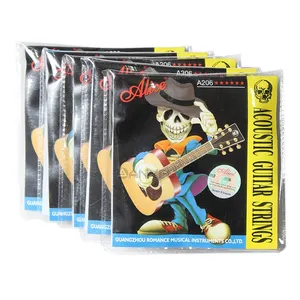(6173 products available)
























































































































































































































 Ready to Ship
Ready to ShipColored guitar strings refer to the visual appealing instrument's strings, which are meant to enhance the overall aesthetic appearance of the guitar. They come in various colors, including purple, blue, orange, green, and red. These strings are normally used to suit individual preferences or match with other guitar parts, like the body or the tuning pegs. Aside from their visual appeal, the colored guitar strings also offer practical benefits. For instance, the coated strings are less rough and have a smoother feeling, which reduces finger wear and improves playability. Moreover, colored string sets are usually marketed together with matching pickguards and other colorful parts, thus enabling players to customize their guitars more extensively.
Colored guitar strings come in different types, and each of them has its unique features. The following are some common types:
Colored guitar strings are used in different scenarios, and this includes:
Follow the below factors to help select the most appropriate colored guitar strings:
Durability
Durable strings have a longer lifespan. Players can enjoy their music longer before changing them. Look for quality string coatings, such as colored guitar strings with nanotechnology. This increases the lifespan of guitar strings while preserving their brightness.
Color Intensity
Guitar string colors can be vibrant or dull. Go for colorful guitar strings with deep hues. The intensity of the color often varies from one brand to another. Some manufacturers offer a variety of colored guitar strings with varying color intensities. Players can pick what best suits their taste and style.
Color Retention
Choose colored guitar strings that do not lose their brightness quickly. Some colors fade after a few weeks, making the guitar look old and unappealing. Check whether the manufacturer has used high-quality dyes that can last long.
String Material
The material used to make guitar strings affects their sound and playability. Common materials are nickel, stainless steel, and bronze. Players can find colored guitar strings in different materials. Consider one that matches the desired sound and playability.
Playability
Colored guitar strings vary in smoothness. Smooth strings are easier to play than rough ones. Check the texture of the string and choose a smooth one if speed is a priority.
Personal Preference
Select colored guitar strings based on individual taste. Some players prefer bright colors, while others go for dull hues. Similarly, some players go for specific brands depending on the brand's quality and consistency. The choice of the color and brand often influences the general satisfaction with the guitar.
Colored guitar strings have numerous functions. First and foremost, they enhance the visual appeal of the guitar, making it more attractive and eye-catching. This is particularly useful for players who use the guitar for live performances or recordings, as the colored strings can help to create a more visually striking and memorable image. In addition to their aesthetic function, colored guitar strings also serve a practical purpose by making it easier for players to quickly identify the different strings and their corresponding notes. This is especially helpful for players who frequently change string gauges or tuning, as the colored strings can help to reduce confusion and ensure that the player is able to quickly and accurately tune the guitar.
Colored guitar strings are designed to be more durable and long-lasting. Many manufacturers use advanced coating technologies, such as nano-technology or PVD (physical vapor deposition), to create a thin, protective layer on the string's surface. This coating not only enhances the string's appearance but also reduces friction and wear, improving playability and lifespan. Some colored strings even feature unique designs or patterns, such as swirls or stripes, which can add an extra level of customization and flair to the guitar.
Q: Do colored guitar strings sound different than regular ones?
No, the colored guitar string’s coating does not affect its sound. The color only changes the appearance of the string. Generally, both the colored and uncolored strings sound the same.
Q: How can one tell when to change colored guitar strings?
When a guitarist plays and notices that the colored guitar strings have lost their brightness and color, it is time to change them. Also, if the strings start to sound dull or rusty, they should be replaced. Moreover, if the strings feel sticky or slippery, they should be changed.
Q: Are colored guitar strings more expensive than regular ones?
Colored guitar strings cost more than regular ones. The coating on the strings is added to enhance their appearance. However, the extra cost is minimal.
Q: Are all colored guitar strings coated?
No, not all colored guitar strings are coated. Some manufacturers use dye to color the strings. The difference between the dye and coating is that the dye penetrates the string’s material, while the coating is applied to the surface.